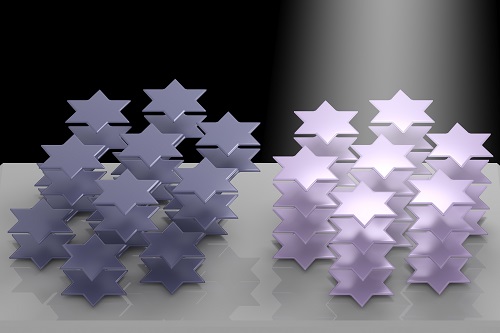A two-dimensional array of tantalum disulfide containing microscopic crystals possesses distinct optical characteristics that can be controlled in ambient conditions and under general illumination, according to researchers at Rice University. The technology could prove useful in 3D displays, virtual reality, and self-driving vehicles.
The researchers found that when they pull a 2D sliver off a bulk sample and shine light on it, the layered material rearranges the charge density waves of electrons flowing through, altering its refractive index.

Atoms in the crystal lattice of tantalum disulfide arrange themselves into six-pointed stars that can be manipulated by light, according to Rice University researchers. The phenomenon can be used to control the material's refractive index. It could become useful for 3D displays, virtual reality, and lidar systems in self-driving vehicles. Courtesy of Weijian Li, Rice University.
Light emitted along the affected axis changes its color depending on the strength of the entering light.
“We need an optical material that can change the refractive index for applications like virtual reality, 3D displays, optical computers, and lidar, which is necessary for autonomous vehicles,” said Gururaj Naik, an assistant professor of electrical and computer engineering at Rice. “At the same time, it has to be fast. Only then can we enable these new technologies.”
Tantalum disulfide’s properties make it a prime candidate for these applications. The material is known for harboring charge density waves at room temperature that allow adjustments to its electrical conductivity, but the strength of light input also changes its refractive index, which quantifies the speed at which light travels through. That makes it tunable, Naik said.
Upon exposure to light, the tantalum layer reorganizes into a lattice of six-pointed, 12-atom stars that facilitate charge density waves. The way in which the stars are stacked determines whether the compound is insulating or metallic along its c-axis.
This also determines its refractive index. Light triggers the stars to realign, changing the charge density weaves enough to affect the material’s optical constants.

Rice University engineer Gururaj Naik and graduate student Weijian Li have discovered that 2D tantalum disulfide has unique light-handling properties that could be useful for 3D displays, virtual reality, and self-driving vehicles. Courtesy of Jeff Fitlow, Rice University.
“This belongs to a class of what we call strongly correlated materials, which means the electrons strongly interact with each other,” graduate student Weijian Li said. “In this case, we can predict the properties that show a strong response to some external stimulus.”
“This is the first material we’ve seen where the interaction of light happens not just with single particles, but with a collection of particles together, at room temperature,” Naik said. The phenomenon appears to work in tantalum disulfide as thin as 10 nm and as thick as 1 mm, he added.
The research was published in Nano Letters (www.doi.org/10.1021/acs.nanolett.0c02234).